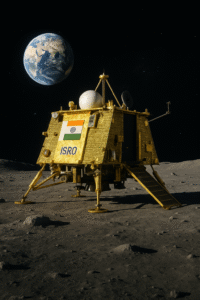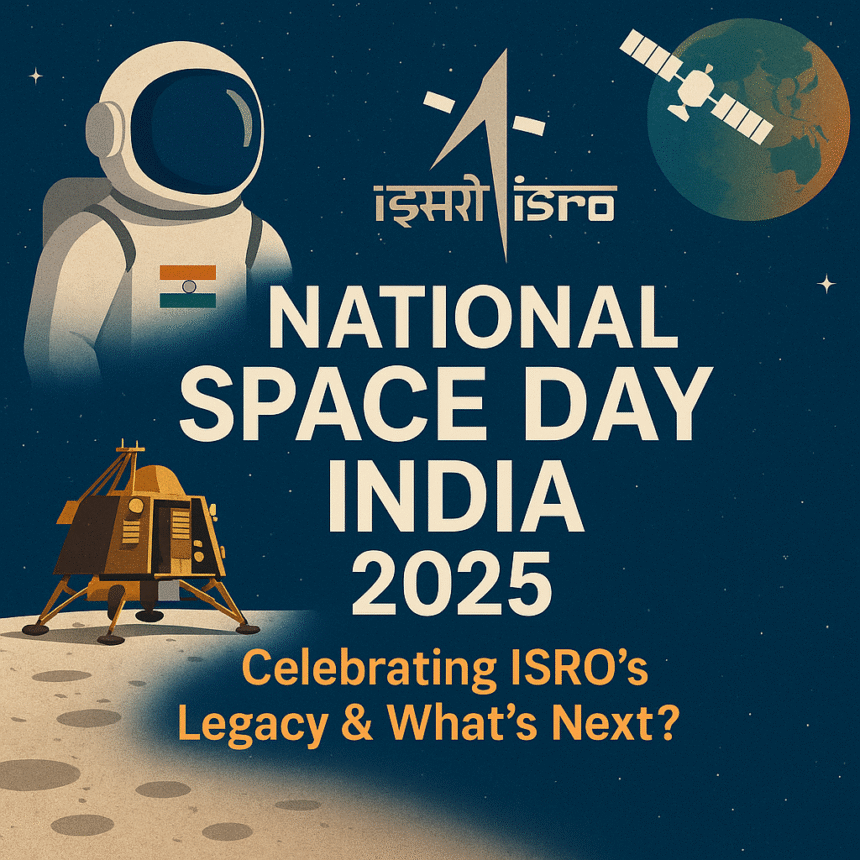🌌 National Space Day India 2025: Chandrayaan-3’s Legacy & Future of ISRO
BY TECHWANTOTREE/AUGUST 23/2025
Introduction
August 23, 2025, holds a very special place in India’s calendar. On this date, the nation celebrates National Space Day India 2025, a commemoration of the historic Chandrayaan-3 mission that successfully soft-landed on the Moon in 2023. The day isn’t just about remembering a scientific achievement; it symbolizes India’s global leadership in space exploration, technological advancement, and the dream of making the impossible possible.
This year’s National Space Day celebrations come with added enthusiasm, as India continues to expand its space policy, global partnerships, and ambitious missions that reach beyond the Moon, aiming at Mars, Venus, and even human spaceflight.
In this article, we will explore the origin of National Space Day, the significance of Chandrayaan-3, the impact on India’s science & technology ecosystem, and most importantly, what the future holds for ISRO and the Indian space sector.
📌 Why August 23 is Celebrated as National Space Day
The decision to celebrate National Space Day on August 23 was announced by the Government of India in 2023, shortly after Chandrayaan-3’s Vikram lander successfully touched down near the Moon’s south pole.
This was no ordinary achievement — India became the first country in the world to land near the south pole of the Moon, an area believed to hold frozen water and valuable minerals. This milestone not only strengthened India’s scientific capabilities but also inspired millions of students and young innovators to dream bigger.
Prime Minister Narendra Modi declared August 23 as “National Space Day” to ensure that future generations always remember the courage, determination, and excellence demonstrated by ISRO scientists.
🚀 The Legacy of Chandrayaan-3
Chandrayaan-3 was the third lunar mission under India’s Chandrayaan program. While Chandrayaan-1 (2008) discovered water molecules on the Moon and Chandrayaan-2 (2019) attempted a landing, it was Chandrayaan-3 that finally fulfilled India’s dream of landing softly on the lunar surface.
Key Achievements of Chandrayaan-3:
-
First successful soft landing near the Moon’s south pole.
-
Rover Pragyan conducted experiments on lunar soil, including sulfur detection.
-
Enhanced India’s position as a leader in affordable space technology.
-
Proved the resilience of India’s scientists after the setback of Chandrayaan-2.
-
Inspired global admiration, making ISRO a respected partner in international collaborations.
This mission showed the world that space exploration is not limited to superpowers. A developing country like India can achieve extraordinary feats with limited budgets and immense talent.
🌍 Impact on India and the World
1. Scientific Breakthroughs
The Pragyan rover analyzed lunar soil composition, which helped in studying potential resources like water ice and minerals. This data is crucial for future missions that may involve human settlement on the Moon.
2. Boost to Space Economy
Chandrayaan-3 attracted global attention, pushing India’s space economy toward a projected USD 44 billion market by 2033. Private startups, academic institutions, and investors now see India as a fertile hub for space innovation.
3. Global Partnerships
India’s lunar success has led to increased partnerships with agencies like NASA, ESA, JAXA, and Roscosmos. Collaborative projects for Mars exploration, space telescopes, and asteroid studies are already under discussion.
4. Youth Inspiration
Perhaps the greatest impact was on students and young innovators. Science fairs, hackathons, and startup ecosystems now flourish with ideas inspired by ISRO’s missions. National Space Day acts as an annual reminder that dreams backed by hard work can touch the stars.
📖 How India Celebrates National Space Day 2025
Across the country, educational institutions, research centers, and science clubs organize activities such as:
-
Workshops and Lectures by ISRO scientists.
-
Space Exhibitions showcasing satellites, rovers, and models.
-
School Competitions on essay writing, quizzes, and debates.
-
Planetarium Shows highlighting India’s space achievements.
-
Public Outreach Campaigns to spread awareness about ISRO’s future projects.
These activities ensure that National Space Day is not just a holiday but a movement that fuels the imagination of every Indian.
🔭 What’s Next for ISRO? The Road Ahead
India is not stopping at Chandrayaan-3. In fact, the mission has acted as a stepping stone toward even bigger and more ambitious goals.
Upcoming Missions and Programs:
-
Gaganyaan Mission
-
India’s first human spaceflight program, aiming to send astronauts (Vyomnauts) into space by 2025–26.
-
This will place India in the elite club of nations with human space capabilities.
-
-
Chandrayaan-4 / Lunar Exploration Continuation
-
Future missions may involve robotic lunar bases and resource mining studies.
-

-
Aditya-L1 Mission (Sun Mission)
-
India’s first space mission dedicated to studying the Sun’s corona and solar activity.
-
-
Mars Orbiter Mission 2 (Mangalyaan-2)
-
Building upon the success of Mangalyaan (2013), India plans a second mission to study Mars in greater detail.
-
-
Shukrayaan (Venus Mission)
-
India is preparing for an orbiter mission to study Venus’s atmosphere, which could reveal secrets about climate change and planetary evolution.
-
-
Space Policy and Private Sector Growth
-
With the new Indian Space Policy, private startups are allowed to build satellites, rockets, and even launch services. This makes India a competitive player in the global space race.
-
🛰️ Why National Space Day Matters in 2025
The 2025 celebration is more than symbolic. It reflects India’s strategic commitment to space as a tool for economic growth, national security, and scientific progress.
-
It reminds the world of India’s capability to innovate at low costs.
-
It inspires youth to pursue STEM careers.
-
It demonstrates how space technology can solve problems on Earth — from weather forecasting to disaster management, agriculture, and communication.
🌠 Global Recognition and India’s Position
International media now recognize ISRO as one of the world’s most efficient and result-oriented space agencies. India’s success is often compared with agencies spending 10x more resources.
Global admiration ensures that India is no longer a follower in space exploration but a leader. With strong diplomacy, India has positioned itself as a reliable partner for future international missions like lunar bases and Mars colonization.
✨ Inspiring the Next Generation
National Space Day is also about passing the torch to the next generation. Today’s schoolchildren who watch ISRO’s rockets take off may become tomorrow’s astronauts, scientists, or innovators.
Educational reforms and government initiatives like Atal Innovation Mission and Startup India are encouraging this new wave of dreamers. By combining innovation + investment + inspiration, India is preparing for a future where space will play a central role in everyday life.
Conclusion
National Space Day India 2025 is not just a celebration — it is a vision for the future. From Chandrayaan-3’s legacy to upcoming missions like Gaganyaan, Aditya-L1, and Shukrayaan, India’s journey in space is a story of dreams, determination, and discovery.
As the tricolor proudly waves not just on Earth but in space, one thing is clear:
India’s space age has just begun, and the sky is no longer the limit.
❓ Frequently Asked Questions (FAQs) – National Space Day India 2025
1. National Space Day India kab manaya jata hai?
Answer: National Space Day India har saal 23 August ko manaya jata hai. Is din ko celebrate karne ka maksad Chandrayaan-3 ki historic Moon landing ko yaad karna hai jo 23 August 2023 ko hui thi.
2. National Space Day India 2025 ka theme kya hai?
Answer: 2025 ka theme hai “Inspiring Young Minds for Space Innovation”, jisme students aur youth ko ISRO ki achievements se inspire karna aur unhe future ke liye space research me motivate karna shamil hai.
3. Chandrayaan-3 mission ka main achievement kya tha?
Answer: Chandrayaan-3 ne Moon ke south pole par successful soft landing ki thi. Ye duniya ki pehli successful south pole landing thi, jisme rover Pragyan ne sulfur aur aur bhi minerals detect kiye.
4. National Space Day ka purpose kya hai?
Answer: Is din ka purpose hai students aur youth ko inspire karna, space awareness badhana, aur ISRO ke future missions ke baare me public ko educate karna. Ye din ek reminder hai ki India ke liye sky is not the limit.
5. ISRO ke upcoming missions 2025 ke baad kaun se hain?
Answer: ISRO ke kuch major upcoming missions hain:
-
Gaganyaan Mission – India’s first human spaceflight.
-
Aditya-L1 – Sun study mission.
-
Mangalyaan-2 – Mars orbiter mission.
-
Shukrayaan – Venus orbiter mission.
6. India ki space economy kitni badi hai?
Answer: Reports ke hisaab se 2033 tak India ki space economy USD 44 billion tak pahunch sakti hai. ISRO ke achievements aur private startups ki growth isko boost kar rahi hai.
7. National Space Day students ke liye kyon important hai?
Answer: Ye din students ko science, technology, engineering aur mathematics (STEM) me career choose karne ke liye encourage karta hai. Competitions, lectures aur exhibitions ke zariye students ko inspire kiya jata hai.
